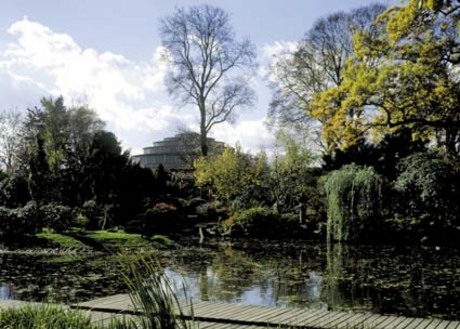Szczytnicki Park
Once you’ve finished ogling the Old Town and Ostrów Tumski, there’s one more district of this fine city that visitors will be poorer heading home without having seen. Just east of the city centre lie a clutch of outdoor attractions surrounding Szczynicki Park and the Centennial Exhibition Complex, including Wrocław’s only UNESCO site, the country’s oldest zoo, the Japanese Garden and the city’s latest ‘tell-me-that-you-love-me’ tourist lure, the Pergola Fountain. Intended as a city showpiece since its creation, the area east of the Odra long held a somewhat lukewarm public standing thanks to dubious historical connotations and debatable aesthetic appeal; however recent renovations, the UNESCO nod and the addition of the magnificent multimedia fountain have made it a favourite place of locals and cemented its place as a Wrocław must-see.
The easiest way to reach Szczynicki Park and the Centennial Exhibition Complex is via public transport. From the city centre hop on trams 2, 4 or 10; alternatively take buses 145 or 146 east. Cross the picturesque Zwierzyniecki Bridge (I-4) and you find yourself immediately alongside the cagey enclosure of the Wrocław Zoological Gardens (I-4/5, see Leisure). A product of the city’s dynamic development in the late 19th century, Wrocław’s zoo dates back to 1865 and became the oldest in the country when Poland inherited it after World War II. Suffering severe wartime damage, many of the zoo’s elegant historic buildings were reconstructed and can be found in the southern part of the park. With over 6000 critters of some 600 different species, the zoo is one of Wrocław’s most visited attractions and provides foreigners with an opportunity to pick up a few phrases from one of the only Polish-speaking macaws in the world (making good money on the side as a voice talent for Polish dubovers of Disney flicks).
Leaving the animal house antics of the zoo, turn onto ulica Wystawowa (Exhibition Street) and you’ll soon find yourself staring down the Centennial Hall promenade, including the ivy-covered columns leading to the towering Iglica monument (see Sightseeing) and monolithic Centennial Hall behind it (I-4, ul. Wystawowa 1). (Please note that the Hall is currently closed for renovation and is expected to re-open in September 2011).
With Wrocław developing rapidly in the late 18th century it was determined that the city required an exhibition hall and the hundred year anniversary of Napoleon’s defeat at the Battle of Leipzig in 1913 was deemed a timely occasion for an expensive, over-the-top exhibition hall that would figuratively flex the architectural muscle of the German Nation. Max Berg, who had been appointed as official city architect in 1909, quickly set about designing his career-piece, and (what-do-ya-know?) his proposal was chosen over 42 others by city council despite abject objection from almost everyone who laid eyes on the design, which resembled a colossal concrete hatbox and would cost an enormous 1.9 million Reichmarks. Teaming with eminent architect Hans Poelzig, the two personally oversaw the project which was completed in 1913 and has become one of the most important architectural monuments of the early 20th century. With an inner diameter of 69 metres, a height of 42 metres and a 10,000 person capacity, the Jahrhunderthalle (as it was called) became the highest structure of its type in the world; that type being a gigantic multi-purpose structure of radial reinforced concrete ribs unlike anything the world had ever seen. Though routinely left off lists of the world’s most attractive buildings, one thing is undeniable: the Centennial Hall is an engineering marvel. Building a structure of such size out of steel and concrete was both revolutionary and extremely daring; in fact the workers that helped build the behemoth were afraid to go inside, so certain were they of its eventual collapse. On the contrary, the Centennial Hall has inexplicably survived two world wars and has in recent years hosted large scale events including monumental operas, sporting events and large concerts. It was here that Adolf Hitler held rallies and Pope John Paul II held services during his famous visit in 1997. With the success of the Centennial Exhibition under its belt, the Jahrhunderthalle was to host an even more intriguing exhibition following World War II. Renamed 'Hala Ludowa' (the People’s Hall), the exhibition centre became the site of the People’s Republic of Poland’s ‘Recovered Territories Exhibition’ (see our box). The most expensive and publicised propaganda event in the history of Poland, since 1948’s Recovered Territories Exhibition and the coinciding International Congress of Intellectuals, the Centennial Hall complex hasn’t quite lived up to its UNESCO-listed reputation for locals and tourists alike, with busloads of the latter often standing in front of the monstrosity wondering how difficult it would be to get the pants they're wearing to qualification for the once exclusive list.
Hang a left from in front of the main entrance and you’ll find yourself a witness to one of the most magnificent attractions Wrocław has to offer. At the start of each hour, the Wrocław Fountain (I-4, see Sightseeing) projects water 40 metres into the air through 300 different nozzles, creating a 700 square metre wall of water on which animated projections are screened while music is piped through the pergola’s sound system. A full multimedia experience, the fountain has been luring tens of thousands of people to the Centennial complex since its June 2009 opening. As reliable as Old Faithful, from May to September this modern marvel performs its hourly spectacle, and costs absolutely nothing.
A stroll away from the colonnades of the pond area puts you in Szczytnicki Park (I-3/4), the oldest and largest recreation space in the city. Covering 115 hectares and laid out in 1785, the once well-groomed former estate park suffered devastation during the Napoleonic Wars and WWII and today largely resembles a natural landscape within the city borders.




